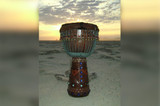Picking the Djembe that is Perfect for You
For many world music fans, the djembe drum represents Africa and all its musical delights. Djembe fans and drummers can be found around the world and the instrument itself is no longer confined to being manufactured in the Motherland. These days, many of the djembes found in stores, festivals, and internet sites were made in places like Bali, Thailand, or Mexico. What this means is that a prospective drummer has to be very careful during djembe selection. When choosing a djembe, it’s important to know some basic information about djembe construction so you don’t become discouraged or hurt due to quality issues. All djembes are not created equal and even djembes that meet the criteria with regard to looks are not necessarily ideal for drumming. Just as it takes skill to drum well on your djembe, it will take some skill to choose the right instrument.
The first qualities to inspect when researching djembe drums will have to do with construction. For first time buyers, it is important to purchase from an actual merchant so that you can try the drum before you take it home. This is good advice, in general, but drummers with more experience in selecting a djembe may be able to buy online more easily simply because they know which companies carry high quality drums and which do not. Once you have tapped on the drums available and found one or two to your liking, it is time to closely inspect the djembe. While small cracks may be filled in and not present a problem, make sure the drum does not have large or multiple filled cracks since those will affect both the sound and life of the drum. Look inside the drum’s shell. A djembe with a smooth interior is not a good investment, as the spiral groove pattern that is traditional for the inside of a djembe helps create the desired sound.
Djembe shopping should be an enjoyable experience that involves all of the senses. Make sure the head is free of holes tears, allowing for some characteristic coloring due to the natural skin used. The beginner djembefola may prefer a thinner hide since it will be easier to drum, but make sure the hide is not thin due to being low quality. Different countries of origin tend to use certain hides for their djembe heads, so ask from where the skin came. Senegal, Mali, Ivory Coast, and Guinea are known for their quality hides. Let your djembe show your inner style with subtle carvings or bright ropes and decorations. You will want to enjoy looking at your djembe, so if it comes down to two or more comparable drums and one has decorations that you enjoy, go with the bling - or not!. Picking your perfect djembe means that the eyes, as well as the ears and hands, get to feast, and you may even find that your djembe drum picks you.
Recent Posts
-
What is the Best Size Djembe for Beginners?
If you're new to the world of percussion and interested in learning the djembe, you're in for a t …16th Jul 2024 -
The Benefits of Becoming a Drumming Teacher: Transforming Passion into Profession
Why become a drumming teacher? Becoming a drumming teacher is an excellent way to share your pas …22nd May 2024 -
What Makes the Djembe Drum a Spiritual Instrument in African Music?
Origin and history of the Djembe drum The Djembe drum originates from West Africa and holds sign …16th May 2024




